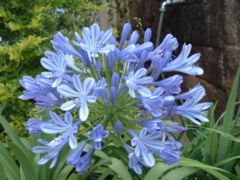Agapanthus africanus
| Agapanthus africanus {{{status}}} Fossil range: {{{fossil_range}}}
| ||||||||||||||||||||||||||||||||||||||||||||||||||||||||||||||||||
|---|---|---|---|---|---|---|---|---|---|---|---|---|---|---|---|---|---|---|---|---|---|---|---|---|---|---|---|---|---|---|---|---|---|---|---|---|---|---|---|---|---|---|---|---|---|---|---|---|---|---|---|---|---|---|---|---|---|---|---|---|---|---|---|---|---|---|
 Flowers | ||||||||||||||||||||||||||||||||||||||||||||||||||||||||||||||||||
| Plant Info | ||||||||||||||||||||||||||||||||||||||||||||||||||||||||||||||||||
| ||||||||||||||||||||||||||||||||||||||||||||||||||||||||||||||||||
| Scientific classification | ||||||||||||||||||||||||||||||||||||||||||||||||||||||||||||||||||
| ||||||||||||||||||||||||||||||||||||||||||||||||||||||||||||||||||
| [[{{{diversity_link}}}|Diversity]] | ||||||||||||||||||||||||||||||||||||||||||||||||||||||||||||||||||
| {{{diversity}}} | ||||||||||||||||||||||||||||||||||||||||||||||||||||||||||||||||||
| Binomial name | ||||||||||||||||||||||||||||||||||||||||||||||||||||||||||||||||||
| Agapanthus africanus (L.) Hoffm. | ||||||||||||||||||||||||||||||||||||||||||||||||||||||||||||||||||
| Trinomial name | ||||||||||||||||||||||||||||||||||||||||||||||||||||||||||||||||||
| {{{trinomial}}} | ||||||||||||||||||||||||||||||||||||||||||||||||||||||||||||||||||
| Type Species | ||||||||||||||||||||||||||||||||||||||||||||||||||||||||||||||||||
| {{{type_species}}} | ||||||||||||||||||||||||||||||||||||||||||||||||||||||||||||||||||
| {{{subdivision_ranks}}} | ||||||||||||||||||||||||||||||||||||||||||||||||||||||||||||||||||
| [[Image:{{{range_map}}}|{{{range_map_width}}}|]] | ||||||||||||||||||||||||||||||||||||||||||||||||||||||||||||||||||
| Synonyms | ||||||||||||||||||||||||||||||||||||||||||||||||||||||||||||||||||
| {{{synonyms}}} |
Agapanthus africanus (African lily, Lily of the Nile; syn. Agapanthus umbellatus) is a member of the family Alliaceae and a native of the Cape of Good Hope in South Africa.
It has a short stem bearing a tuft of long, narrow, arching leaves 10-35 cm long and 1-2 cm broad, and a central flower stalk 25-60 cm tall, ending in an umbel of 20-30 bright blue, funnel-shaped flowers, each flower 2.5-5 cm diameter.
Cultivation
It was introduced to Europe at the close of the 17th century as a handsome greenhouse plant, and is hardy outdoors in the south of England and Ireland if protected from severe frosts. The plants are easy to cultivate and (in areas that have winter) are generally grown in large pots or tubs that can be protected from frost.
Several cultivars are known, such as 'Albus' (with white flowers), 'Sapphire' (dark blue flowers), 'Aureus' (leaves striped with yellow), and 'Variegatus' (leaves almost entirely white with a few green bands). There are also double-flowered and larger- and smaller-flowered cultivars.
During the summer they require plenty of water and are very effective on the margins of lakes or by running streams, where they thrive. They may be propagated from offsets or by dividing the rootstock in early spring or autumn.
References
- Bailey, L. H. (1920). Manual of Gardening, a Practical Guide to the Making of Home Grounds (2nd Ed. ed.). New York: Macmillan. Project Gutenberg Literary Archive Foundation. OCLC 2481316. http://www.gutenberg.org/etext/9550.